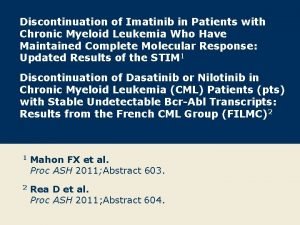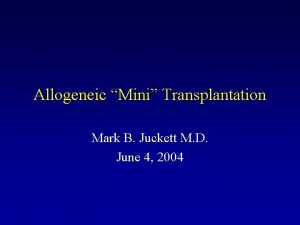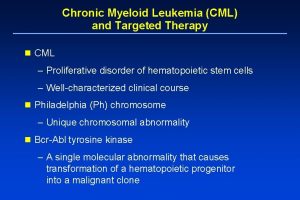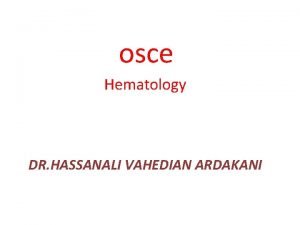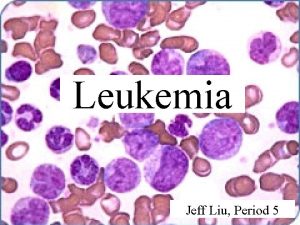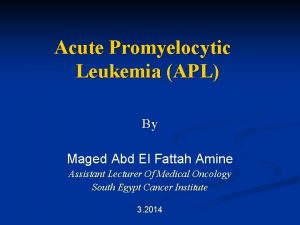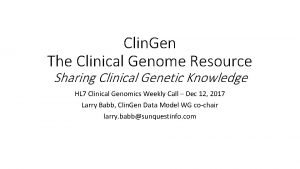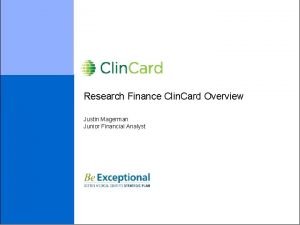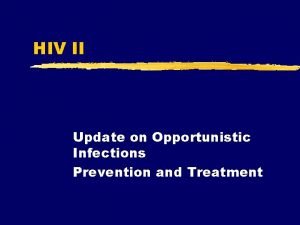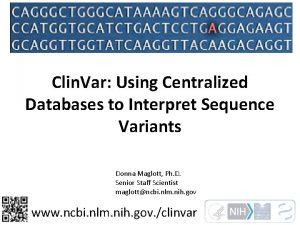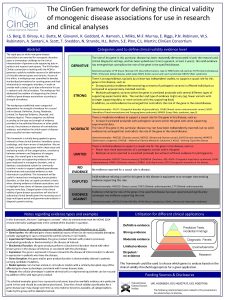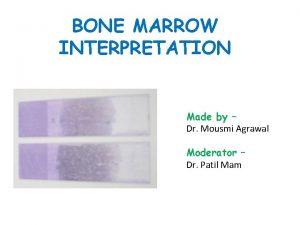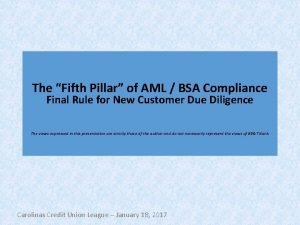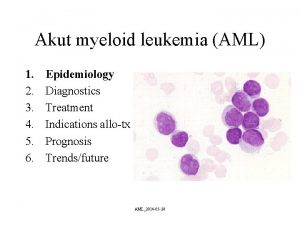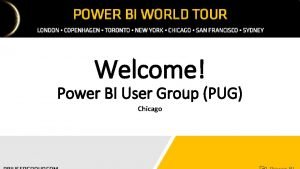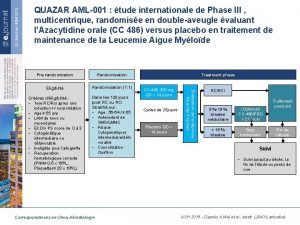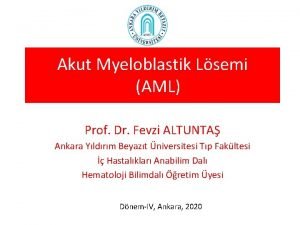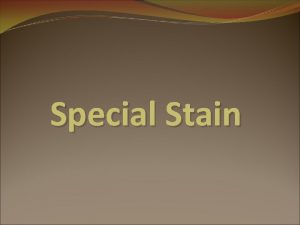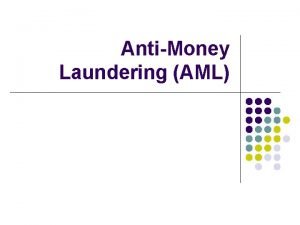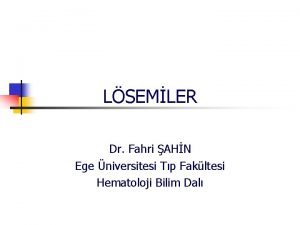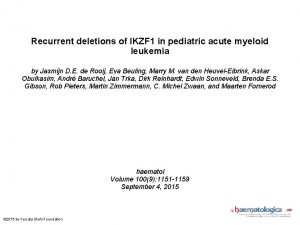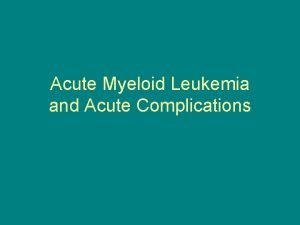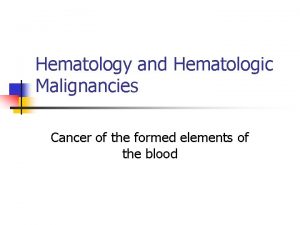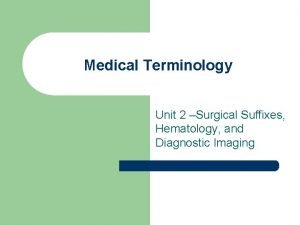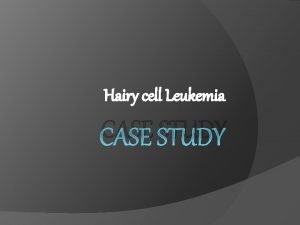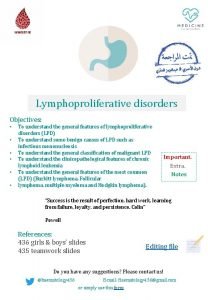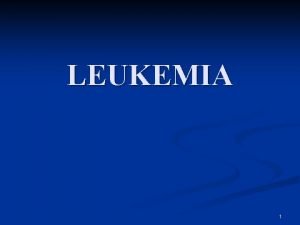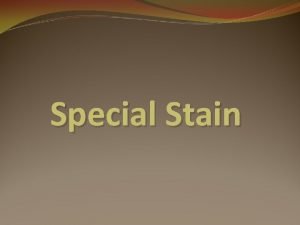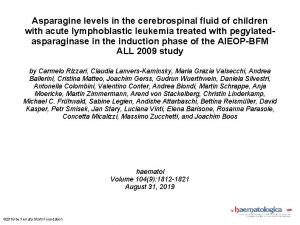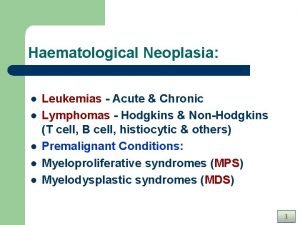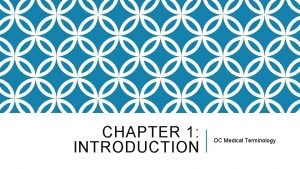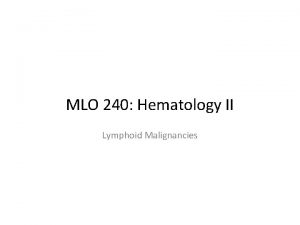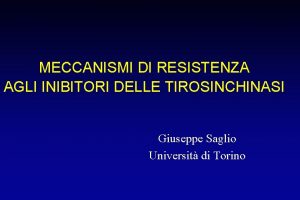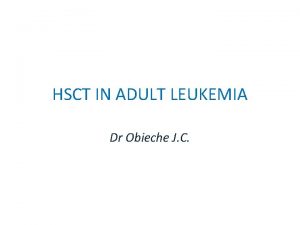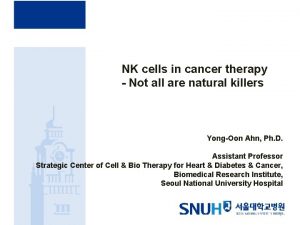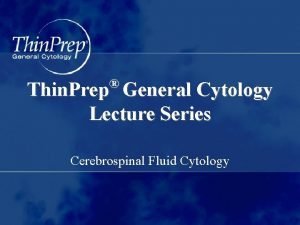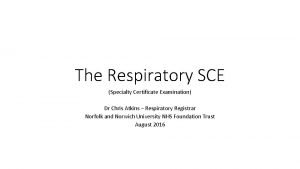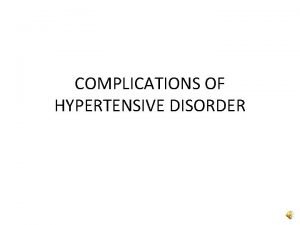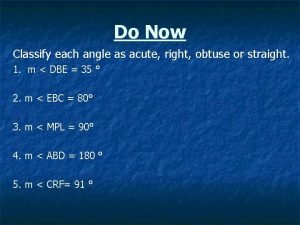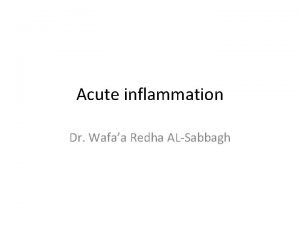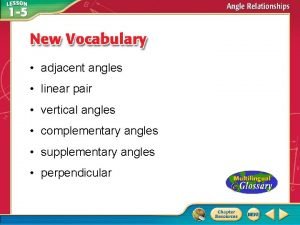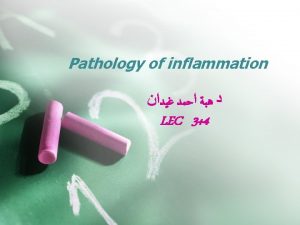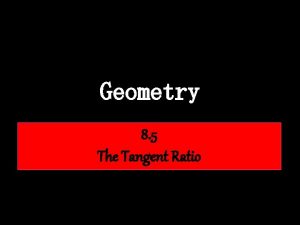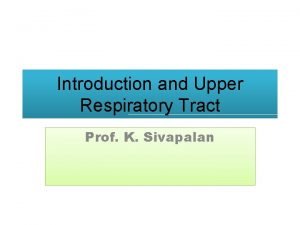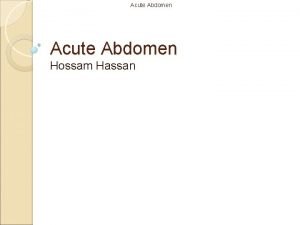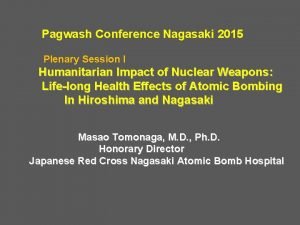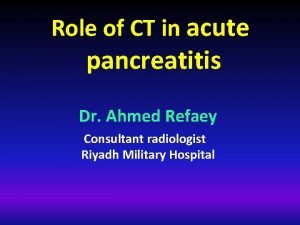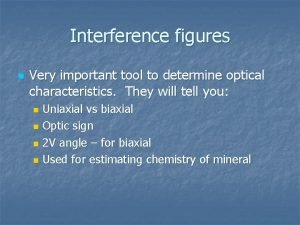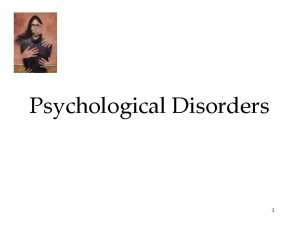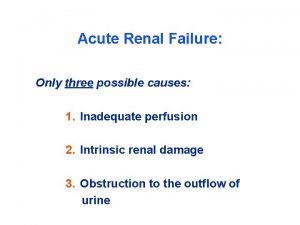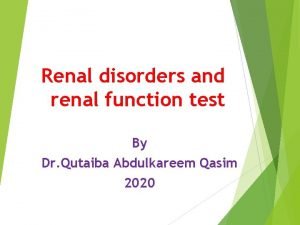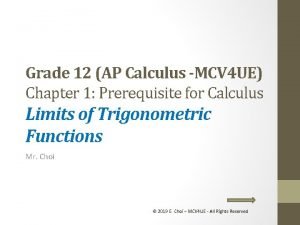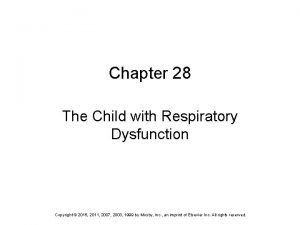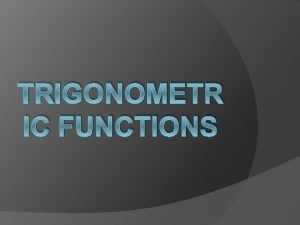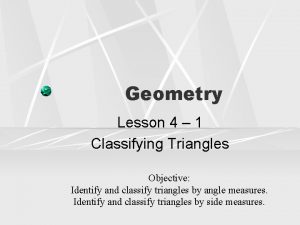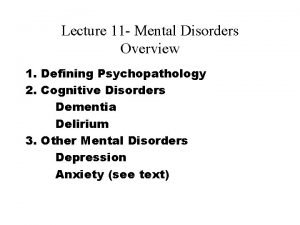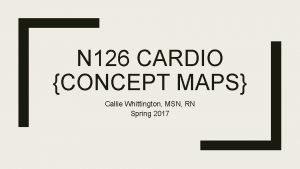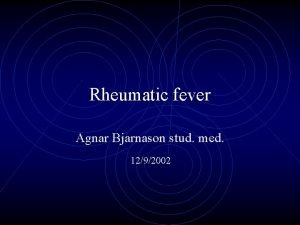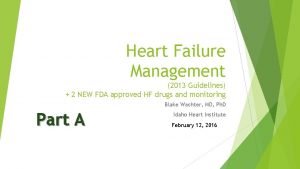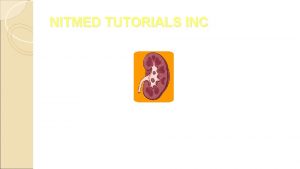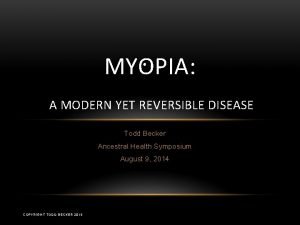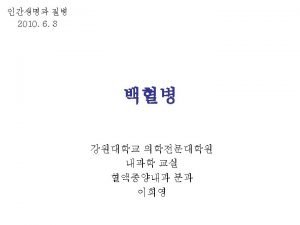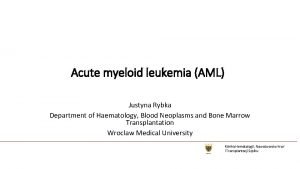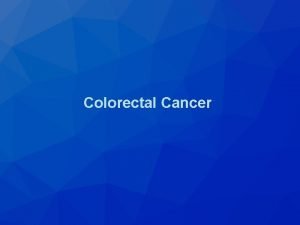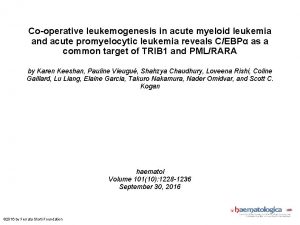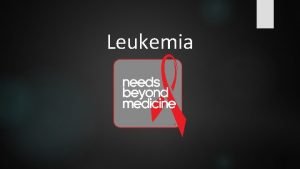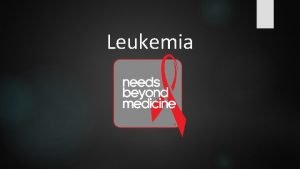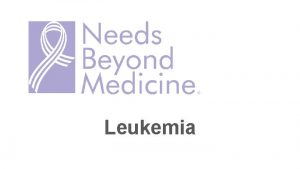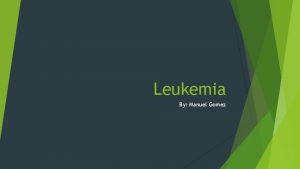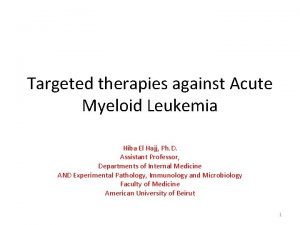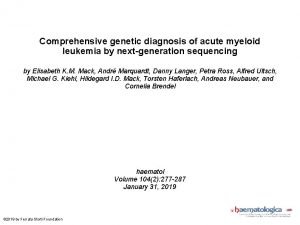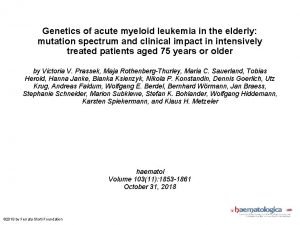Acute Myeloid Leukemia AML J Clin Oncol 2018

![J Clin Oncol 2018; [Epub ahead of print]. J Clin Oncol 2018; [Epub ahead of print].](https://slidetodoc.com/presentation_image_h/f12896decf84f761c20f99ca39f072ef/image-2.jpg)



















































































- Slides: 85

Acute Myeloid Leukemia (AML)
![J Clin Oncol 2018 Epub ahead of print J Clin Oncol 2018; [Epub ahead of print].](https://slidetodoc.com/presentation_image_h/f12896decf84f761c20f99ca39f072ef/image-2.jpg)
J Clin Oncol 2018; [Epub ahead of print].

CLTR 0310 -301: Phase III Study of CPX-351 versus 7+3 Chemotherapy Induction and Consolidation Accrual (N = 309) • 60 -75 years old • Newly diagnosed therapy-related AML or AML with MDS/CMML or de novo AML with MDS-related cytogenic abnormalities CPX-351 1: 1 R 7+3 (cytarabine + daunorubicin) Primary Endpoint: Overall survival Secondary Endpoints: Remission rate, remission duration, EFS Lancet JE et al. J Clin Oncol 2018; [Epub ahead of print].

CLTR 0310 -301: Overall Survival No. of patients Median survival, years CPX-351 153 9. 56 7+3 156 5. 95 Group HR = 0. 69 One-sided P = 0. 003 Lancet JE et al. J Clin Oncol 2018; [Epub ahead of print].

CLTR 0310 -301: Most Frequently Reported Adverse Events Lancet JE et al. J Clin Oncol 2018; [Epub ahead of print].

N Engl J Med 2018; 378(25): 2386 -98.

Ivosidenib for Patients with an IDH 1 Mutation: Efficacy R/R AML (n = 179) Untreated AML (n = 34) Overall response 39. 1% 55. 9% CR 21. 8% 20. 6% CRi or CRp 11. 7% 20. 6% 0 2. 9% MLFS or bone marrow CR 5. 6% 11. 8% Median duration of response 6. 5 mo 9. 2 mo PR CR = complete response; CRi = CR with incomplete hematologic recovery; CRp = CR with incomplete platelet recovery; PR = partial response; MLFS = morphologic leukemia-free state • Patients with R/R AML in the primary efficacy group (n = 125) had a median overall survival of 8. 8 months Di. Nardo C et al. N Engl J Med 2018; 378(25): 2386 -98.

Ivosidenib for Patients with an IDH 1 Mutation: Tolerability R/R AML, 500 mg/d starting dose (n = 179) All patients (n = 258) ≥ 1 TRAE Grade 3 or higher 20. 7% 25. 6% Prolongation of QT interval 7. 8% 7. 0% IDH differentiation syndrome 3. 9% 4. 7% Anemia 2. 2% 2. 3% Thrombocytopenia 1. 7% 1. 9% Leukocytosis 1. 7% 1. 2% Febrile neutropenia 0. 6% 1. 2% Event TRAE = treatment-related adverse event Di. Nardo C et al. N Engl J Med 2018; 378(25): 2386 -98.

Blood 2017; 130(6): 722 -31.

Enasidenib for Patients with an IDH 2 Mutation: Efficacy Evolution of response in responding patients Number of patients N = 71 Relapse/PD SD PR MLFS Cri/CRp CR Treatment cycle Stein EM et al. Blood 2017; 130(6): 722 -31. All doses (n = 176) Overall response 40. 3% CR 19. 3% CRi or CRp 6. 8% Median duration of response 5. 6 mo Median overall survival 9. 3 mo

Enasidenib for Patients with an IDH 2 Mutation: Select Grade 3 and 4 TRAEs 100 mg dose (n = 153) All patients (n = 239) Hyperbilirubinemia 8% 12% IDH differentiation syndrome 7% 6% Anemia 7% 5% Thrombocytopenia 5% 6% Tumor lysis syndrome) TLS( 3% 3% Leukocytosis 1% 3% Lipase increased 1% 2% TRAE • 5% of patients discontinued therapy as a result of TRAEs Stein EM et al. Blood 2017; 130(6): 722 -31.

Ivosidenib or Enasidenib Combined with Standard Induction Chemotherapy Is Well Tolerated and Active in Patients with Newly Diagnosed AML with an IDH 1 or IDH 2 Mutation: Initial Results from a Phase 1 Trial Stein EM et al. Proc ASH 2017; Abstract 726.

Ivosidenib or Enasidenib for Patients with Newly Diagnosed IDH-Mutated AML Ivosidenib + chemotherapy Enasidenib + chemotherapy De novo AML (n = 14) Secondary AML (n = 9) Overall (n = 23) De novo AML (n = 18) Overall response 93% 67% 83% 79% 81% CR 71% 33% 57% 56% 32% 43% CRi or CRp 14% 11% 13% 11% 26% 19% 0 11% 4% 17% 21% 19% 7% 11% 9% 0 0 0 MLFS PR Stein EM et al. Proc ASH 2017; Abstract 726. Secondary AML Overall (n = 19) (n = 37)

Ivosidenib or Enasidenib for Patients with Newly Diagnosed IDH-Mutated AML Ivosidenib + chemotherapy (n = 27) Enasidenib + chemotherapy (n = 38) Any adverse event 93% 92% Febrile neutropenia 56% 63% ALT increase 11% 0 AST increase 11% 0 Colitis 11% 8% Hypertension 7% 11% Respiratory failure 7% 5% 0 8% Select Grade ≥ 3 TEAEs Rash TEAE = treatment-emergent adverse events Stein EM et al. Proc ASH 2017; Abstract 726.

Mutant IDH (m. IDH) Inhibitors, Ivosidenib or Enasidenib, with Azacitidine (AZA) in Patients with Acute Myeloid Leukemia (AML) Di. Nardo CD et al. Proc ASCO 2018; Abstract 7042.

m. IDH Inhibitors with AZA for Patients with Newly Diagnosed AML Ineligible for Intensive Chemotherapy Ivosidenib + AZA (n = 23) Enasidenib + AZA (n = 6) Overall response 78% 67% CR 44% 50% CRi or CRp 22% 0 0 0 13% 17% Response PR MLFS Di. Nardo C et al. Proc ASCO 2018; Abstract 7042.

m. IDH Inhibitors with AZA for Patients with Newly Diagnosed AML Ineligible for Intensive Chemotherapy Ivosidenib + AZA (n = 23) Enasidenib + AZA (n = 6) Hyperbilirubinemia NR 33% Anemia 44% 50% Thrombocytopenia 44% 50% Neutropenia 39%* 33% Lung infection NR 33% Pneumonia NR 33% Hypoxia NR 17% QT interval prolongation 13% NR Select Grade 3/4 TEAEs * Febrile neutropenia NR = Not reported Di. Nardo C et al. Proc ASCO 2018; Abstract 7042.

AGILE: Phase III Study of Azacitidine with or without Ivosidenib + azacitidine Accrual (N = 392) • Previously untreated AML • Unwilling to receive or not candidates for intensive chemotherapy • IDH 1 mutation 1: 1 R Placebo + azacitidine Primary endpoint: Overall survival Secondary endpoints include remission rate, duration of response, EFS, safety Stein E et al. Proc ASCO 2018; Abstract TPS 7074.

Durable Response with Venetoclax in Combination with Decitabine or Azacitidine in Elderly Patients with Acute Myeloid Leukemia (AML) Di. Nardo CD et al. Proc ASCO 2018; Abstract 7010.

Venetoclax in Combination with Azacitidine or Decitabine: Response Rates by Subgroup Rate of response (%) Patients (%) with CR/CRi shown at the top of each bar Other RD MLFS PR CRi CR CR = complete remission; CRi = CR with incomplete blood count recovery; PR = partial remission; MLFS = morphogenic leukemia free state; RD = resistant disease Other: disease progression, or discontinued prior to assessment Di. Nardo CD et al. Proc ASCO 2018; Abstract 7010.

Venetoclax in Combination with Azacitidine or Decitabine: Tolerability Serious AEs in ≥ 3% of patients N = 145 Any event 70% Febrile neutropenia 32% Pneumonia 12% Bacterial infection 6% Lung infection 5% Sepsis 4% Hypotension 3% Mental status changes 3% Gastrointestinal hemorrhage 3% • No events of clinical or laboratory TLS were observed Mucosal inflammation 3% • No events of clinical or laboratory TLS were observed Di. Nardo CD et al. Proc ASCO 2018; Abstract 7010.

Phase 1/2 Study of Venetoclax (VEN) with Low-Dose Cytarabine (LDAC) in Treatment-Naïve, Elderly Patients with Acute Myeloid Leukemia Unfit for Intensive Chemotherapy: 1 -Year Outcomes Wei A et al. Proc ASH 2017; Abstract 890.

Response to VEN with LDAC in Elderly Patients with AML Not Eligible for Intensive Chemotherapy CR/CRi Median duration of CR/CRi (months) Median OS (months) Intermediate (37) 76% NR 15. 7 Poor (19) 47% 3. 1 5. 7 NPM 1 (7) 100% NR NR DNMT 3 A (11) 82% NR NR FLT 3 -ITD (9) 78% 7. 4 14. 0 TP 53 (9) 44% 3. 0 6. 6 IDH 1/2 (10) 70% NR 9. 3 SRSF 2 (16) 75% NR 9. 0 RUNX 1 (9) 56% 9. 0 3. 8 Patients (n) Cytogenetic risk Biomarker Wei A et al. Proc ASH 2017; Abstract 890.

Lancet Oncol 2018; 19(7): 889 -903.

Quizartinib for R/R AML: Efficacy • • Cohort 1: Patients ≥ 60 years old, R/R AML within 1 year of first-line therapy (excluding stem cell transplant) Cohort 2: Patients 18 to 85 years old, R/R AML after salvage chemotherapy or hematopoietic stem cell transplant (HSCT) Cohort 1 Cohort 2 FLT 3 -ITD positive (n = 112) FLT 3 -ITD negative (n = 44) FLT 3 -ITD positive (n = 136) FLT 3 -ITD negative (n = 40) Overall response 77% 45% 74% 45% CR 3% 5% 4% 3% CRp 4% 2% 1% 3% CRi 50% 30% 40% 25% PR 21% 9% 29% 15% Median overall survival (weeks) 25. 4 19. 1 24. 0 25. 1 Cortes J et al. Lancet Oncol 2018; 19(7): 889 -903.

Quizartinib for R/R AML: Tolerability Grade ≥ 3 TRAEs in ≥ 10% of patients All patients (n = 333) Febrile neutropenia 41% Anemia 26% Thrombocytopenia 15% QTc. F prolongation 11% Neutropenia 11% Leucopenia 7% Decreased platelet count 8% Pneumonia 13% Cortes J et al. Lancet Oncol 2018; 19(7): 889 -903.

Quizartinib Significantly Prolongs Overall Survival in Patients with FLT 3 Internal Tandem Duplication–Mutated (Mut) Relapsed/Refractory AML in the Phase 3, Randomized, Controlled Qu. ANTUM-R Trial Cortes J et al. Proc EHA 2018; Abstract LB 2600.

Phase III Qu. ANTUM-R: Efficacy Quizartinib (n = 245) Salvage chemotherapy (n = 122) Median OS 27 wk 20. 4 wk 1 year OS 27% 20% Survival HR, p-value 0. 76, p = 0. 0177 Median drug exposure: Quizartinib 4 cycles, salvage chemotherapy 1 cycle Cortes J et al. Proc EHA 2018; Abstract LB 2600.

Phase III Qu. ANTUM-R: Tolerability Quizartinib (n = 241) Salvage chemotherapy (n = 94) Thrombocytopenia 35% 34% Anemia 30% 29% Febrile neutropenia 31% 21% Leukopenia 17% 16% Sepsis/septic shock 16% 18% Hypokalemia 12% 9% Pneumonia 12% 9% Select Grade ≥ 3 AEs in >10% of patients • 2 patients discontinued quizartinib due to QTc. F prolongation Cortes J et al. Proc EHA 2018; Abstract LB 2600; http: //www. ascopost. com/News/58973.

Low Relapse Rate in Younger Patients ≤ 60 Years Old with Newly Diagnosed FLT 3 -Mutated Acute Myeloid Leukemia (AML) Treated with Crenolanib and Cytarabine/Anthracycline Chemotherapy Wang ES et al. Proc ASH 2017; Abstract 566.

Crenolanib in Combination with Chemotherapy for Newly Diagnosed FLT 3 -Mutant AML • 21 of 29 (72%) patients achieved a CR after one cycle of induction with chemotherapy with crenolanib – 3 additional patients achieved a CR after re-induction, 7+3 induction and high-dose cytarabine or HSCT • 23 of 24 patients in CR in follow-up (median follow-up = 14 months) – 1 death (post-transplant complications) – 2 relapses: • 1 bone marrow • 1 CNS Wang ES et al. Proc ASH 2017; Abstract 566.

Crenolanib in Combination with Chemotherapy for Newly Diagnosed FLT 3 -Mutant AML DFS in 24 patients in CR Overall survival (%) Disease-free survival (%) OS in 24 patients in CR Months Wang ES et al. Proc ASH 2017; Abstract 566. Months

Lancet Oncol 2017; 18(8): 1061 -75.

Gilteritinib for R/R AML: Efficacy FLT 3 -WT (n = 58) FLT 3 -mutant (n = 191) All patients (n = 249) Overall response 12% 49% 40% CR 2% 9% 8% CRp 0 5% 4% CRi 7% 22% 18% PR 3% 12% 10% Median duration of response 12 weeks 20 weeks 17 weeks Median overall survival 17 weeks 30 weeks 25 weeks Perl AE et al. Lancet Oncol 2017; 18(8): 1061 -75.

Gilteritinib for R/R AML: Tolerability Most common Grade 3 -4 AEs • All patients (n = 252) Febrile neutropenia 39% Anemia 25% Thrombocytopenia 13% Sepsis 14% Pneumonia 12% 9% of patients had a greater than 60 ms change in their maximum postbaseline QTc. F relative to baseline Perl AE et al. Lancet Oncol 2017; 18(8): 1061 -75.

Preliminary Results from a Phase 1 Study of Gilteritinib in Combination with Induction and Consolidation Chemotherapy in Subjects with Newly Diagnosed Acute Myeloid Leukemia (AML) Pratz KW et al. Proc ASH 2017; Abstract 722.

Response and Safety with Gilteritinib and Induction and Consolidation Chemotherapy in AML Response parameters All patients (N = 49) FLT 3 mut+ (n = 23)1 CRc 71. 4% 91. 3% CR 57. 1% 82. 6% Treatment-emergent adverse events (Grade ≥ 3) Febrile neutropenia 53. 1% Thrombocytopenia 18. 4% Neutropenia 16. 3% Decreased platelet count 12. 2% Sepsis 10. 2% Decreased WBC 10. 2% 1 FLT 3 mutation status was unknown for 1 patient CRc = complete response (CR) with incomplete platelet recovery + CR with incomplete hematologic recovery Serious drug-related adverse events: febrile neutropenia (16. 3%), sepsis (6. 1%) and decreased ejection fraction (4. 1%) Pratz K et al. Proc ASH 2017; Abstract 722.

Cancer 2018; 124(9): 1954 -63.

Cumulative incidence of relapse Relapse Mortality Stratified by Use of Sorafenib Before and After Transplantation 3 -year cumulative relapse rate: Group A = 22. 2% Group B = 18. 8% Group C = 15. 8% Group D = 46. 1% * P = 0. 006 Months after transplantation Xuan L et al. Cancer 2018; 124(9): 1954 -63. • Group A (n = 36): sorafenib before transplantation • Group B (n = 32): sorafenib maintenance after transplantation • Group C (n = 26): sorafenib both before and after transplantation • Group D (n = 50): sorafenib neither before nor after transplantation

The Addition of Sorafenib to Standard AML Treatment Results in a Substantial Reduction in Relapse Risk and Improved Survival. Updated Results from Long-Term Follow-Up of the Randomized-Controlled Soraml Trial Rollig C et al. Proc ASH 2017; Abstract 721.

SORAML: Overall Survival Overall survival (%) Placebo + chemotherapy (n = 133) Sorafenib + chemotherapy (n = 134) Sorafenib + chemotherapy Placebo + chemotherapy HR, p-value Median EFS 26 mo 9 mo 0. 68, 0. 01 Median OS Not reached 83 mo 61% 52% Five-year OS Months from randomization Rollig C et al. Proc ASH 2017; Abstract 721. 0. 81, 0. 263

Minimal-Residual Disease Guided Treatment with Azacitidine in MDS/AML Patients at Imminent Risk of Relapse: Results of the Prospective RELAZA 2 Trial Platzbecker U et al. Proc ASH 2017; Abstract 565.

RELAZA 2: MRD-Guided Treatment with Azacitidine • 205 patients (n = 27 MDS, n = 178 AML) in CR after chemotherapy alone (n = 58) or allogeneic HSCT (n = 147) • MRD monitored in peripheral blood or bone marrow monthly for two years • Patients with MRD above a specific threshold but still in CR received 6 cycles of azacitidine preemptively • Patients could receive up to 18 months of additional azacitidine-based treatment based on MRD • Patients with a hematologic relapse came off study Platzbecker U et al. Proc ASH 2017; Abstract 565.

RELAZA 2: MRD-Guided Treatment with Azacitidine • 53 of 205 patients (26%) became MRD positive while still in hematologic CR and received azacitidine – After 6 months, 31 of 53 patients were still in CR (58%) • 21 patients declined below the MRD threshold • 10 patients stabilized with no relapse – 22 patients relapsed after a median of 3 cycles of azacitidine • After 6 months, 24 patients continued to receive median 9 cycles of azacitidine – 8 relapsed after a median of 397 days after an initial MRD detection Platzbecker U et al. Proc ASH 2017; Abstract 565.

Phase 2 Study of Combination of Cytarabine, Idarubicin, and Nivolumab for Initial Therapy of Patients with Newly Diagnosed Acute Myeloid Leukemia Ravandi F et al. Proc ASH 2017; Abstract 815.

Nivolumab in Combination with Induction Chemotherapy for Newly Diagnosed AML • 32 patients treated with nivolumab after induction with ara -C and idarubicin – 24 de novo AML – 2 therapy-related AML – 3 secondary AML – 1 therapy-related secondary AML – 2 high-risk MDS • 23 patients achieved CR/CRi (72%) • Median RFS: not reached • Median OS: not reached • Immune-related toxicities in 5 patients – Rash, pancreatitis and colitis Ravandi F et al. Proc ASH 2017; Abstract 815.

N Engl J Med 2018; 378(13): 1189 -99.

Detection of Persistent Non-DTA Mutations During CR Is Associated with Increased Risk of Relapse and Decreased OS Relapse among all patients Overall survival among all patients Patients with relapse (%) Training cohort, P = 0. 001 Validation cohort, P < 0. 001 Detection of non-DTA mutation No detection of non-DTA mutation • (n = 44) (n = 103) Patients who were alive (%) (n = 78) (n = 205) Training cohort, P = 0. 001 Validation cohort, P < 0. 001 No detection of non-DTA mutation Detection of non-DTA mutation The detection of persistent DTA mutations, which are often present in persons with agerelated clonal hematopoiesis, was not associated with an increased relapse rate. Jongen-Lavrencic M et al. N Engl J Med 2018; 378(13): 1189 -99.

Rate of Relapse by Detection of Persistent Non-DTA Mutations During CR with Next-Generation Sequencing (NGS) and Multiparameter Flow Cytometry (MFC) Jongen-Lavrencic M et al. N Engl J Med 2018; 378(13): 1189 -99.

A Phase 2 Randomized Study of Low Dose Ara-C with or without Glasdegib (PF-04449913) in Untreated Patients with Acute Myeloid Leukemia or High. Risk Myelodysplastic Syndrome Cortes JE et al. Proc ASH 2016; Abstract 99.

Overall Survival with Low-Dose Ara-C with or without Glasdegib for Untreated AML or High. Risk MDS LDAC + glasdegib N = 88 LDAC alone N = 44 Median follow-up (months) 14. 3 12. 4 Median OS (months) 8. 3 4. 9 N = 55 N = 27 12. 2 6. 0 N = 33 N = 17 4. 4 2. 3 All patients Good/intermediate risk Median OS (months) Poor risk Median OS (months) Cortes JE et al. Proc ASH 2016; Abstract 99. HR p-value 0. 511 0. 0020 0. 464 0. 0035 0. 575 0. 0422

Acute Lymphoblastic Leukemia (ALL)

N Engl J Med 2018; 378(5): 439 -48.

Tisagenlecleucel for Children and Young Adults with R/R ALL: Efficacy Duration of remission for patients achieving a CR or CRi Tisagenlecleucel (n = 75) • Overall remission rate 81% CR 60% CRi 21% 1 -year EFS 50% 1 -year OS 76% The median duration of persistence of tisagenlecleucel in blood was 168 days Maude SL et al. N Engl J Med 2018; 378(5): 439 -48.

Tisagenlecleucel for Children and Young Adults with R/R ALL: Tolerability ≤ 8 weeks after infusion) n = 75( Grade 3 Grade 4 Any event 25% 44% Cytokine release syndrome 21% 25% Hypotension 9% 8% Neurologic event 13% 0 Decrease in lymphocyte count 7% 5% Increase in blood bilirubin 11% 0 Increase in AST 7% 3% Select Grade 3 or 4 AE • From 8 weeks to 1 year after infusion) n = 70): – 11% experienced a Grade 3 AE – 6% experienced a Grade 4 AE Maude SL et al. N Engl J Med 2018; 378(5): 439 -48.

Outcomes of Patients (pts) Treated with Prior Blinatumomab (Blin) in ZUMA-3: A Study of KTE-C 19, an Anti. CD 19 Chimeric Antigen Receptor (CAR) T Cell Therapy, in Adult Pts with Relapsed/Refractory Acute Lymphoblastic Leukemia (R/R ALL) Shah BD et al. Proc ASCO 2018; Abstract 7006.

ZUMA-3: KTE-C 19 for Adult Patients with R/R ALL: Efficacy After 8 Weeks Follow-Up Prior blin (n = 8) Blin-naïve (N = 10) Overall (n = 18) CR rate 63% 80% 72% CRi 0 0 0 88% 100% 94% Undetectable MRD • 5/6 patients who did not respond to prior blinatumomab achieved undetectable MRD response to KTE-C 19 Shah BD et al. Proc ASCO 2018; Abstract 7006.

ZUMA-3: KTE-C 19 for Adult Patients with R/R ALL: Tolerability Prior blin (n = 11) Blin-naïve (N = 12) Overall (n = 23) CRS 27% 17% 22% Neurologic events 36% 67% 52% Grade ≥ 3 AE • Most frequent Grade ≥ 3 CRS symptoms: – Pyrexia (39%) – Hypotension (30%) • Most frequent Grade ≥ 3 neurologic events: – Encephalopathy (22%) – Aphasia (17%) – Confusional state (13%) Shah BD et al. Proc ASCO 2018; Abstract 7006.

N Engl J Med 2018; 378(5): 449 -59.

19 -28 z T Cells for R/R ALL: Remission Rates by Subgroup Park JH et al. N Engl J Med 2018; 378(5): 449 -59.

19 -28 z T Cells for R/R ALL: Survival by Disease Burden Park JH et al. N Engl J Med 2018; 378(5): 449 -59.

19 -28 z T Cells for R/R ALL: Tolerability by Subgroup Park JH et al. N Engl J Med 2018; 378(5): 449 -59.

Tumor Gene Signature Associated with Neurotoxicity in R/R B-ALL Patients Treated with JCAR 015, A CD 19 -Directed CAR T Cell Product Olson NE et al. Proc ASCO 2018; Abstract 7007.

Neurotoxicity associated with ALL subtype • Analysis of patients enrolled on the ROCKET trial of JCAR 015 – Differential gene expression between low neurotoxicity (Grade 0 -1) and high neurotoxicity (Grade 4 -5) – Compared these genes to the TARGET database of 250 B-ALL samples – Grade 0 -1 neurotoxicity genes were expressed in Ph+/Ph-like samples – Grade 4 -5 neurotoxicity genes were expressed in non. Ph-like samples Olson NE et al. Proc ASCO 2018; Abstract 7007.

Classification System Extrapolated to 3 Other BALL CD 19 CAR T studies MSK 09 -114 NCT 01044069 BCR-ABL only BCR-ABL and Ph-like Max neurotoxicity grade Total 0 1 2 3 4 5 Not Ph+ 36 14 5 0 14 3 0 Ph+ 15 6 3 2 4 0 0 Not Ph+ 38 19 4 3 8 2 2 Ph+ 9 3 2 2 2 0 0 PHCRC 2639 (B-ALL) NCT 01865617 PLAT-02 NCT 02028455 Total 0 -3 4 5 Non-Ph 35 32 3 0 Ph+/Ph-like 8 8 0 0 All trials Total Grade 0 -3 Grades 4 -5 Non-Ph 124 107 17 Ph+/Ph-like 48 48 0 Olson NE et al. Proc ASCO 2018; Abstract 7007.

N Engl J Med 2017; 376(9): 836 -47.

TOWER: Phase III Study of Blinatumomab vs So. C Chemo in R/R ALL — Survival and Response Blinatumomab n = 271 So. C chemo n = 134 HR or odds ratio, p-value Median OS 7. 7 mo 4. 0 mo HR 0. 71, p = 0. 01 CR/CRi/CRh 43. 9% 24. 6% OR 2. 40, p < 0. 001 )n = 271( )n = 134( CRh = CR with partial hematologic recovery Kantarjian H et al. N Engl J Med 2017; 376(9): 836 -47.

TOWER: Phase III Study of Blinatumomab vs So. C Chemo in R/R ALL — Remission Rate by Subgroup Kantarjian H et al. N Engl J Med 2017; 376(9): 836 -47.

TOWER: Phase III Study of Blinatumomab vs So. C Chemo in R/R ALL — Tolerability Blinatumomab group (n = 267) Chemotherapy group (N = 109) No. of patients, % Event leading to premature discontinuation of trial treatment 12. 4 8. 3 Fatal serious adverse event 19. 1 17. 4 Neutropenia 37. 8 57. 8 Infection 34. 1 52. 3 Neurologic event 9. 4 8. 3 Cytokine release syndrome 4. 9 0 Infusion reaction 3. 4 0. 9 Lymphopenia 1. 5 3. 7 Select Grade ≥ 3 AE in ≥ 3% of patients Kantarjian H et al. N Engl J Med 2017; 376(9): 836 -47.

Blood 2018; 131(14): 1522 -31.

Blinatumomab for Patients in CR with MRD: Complete MRD Response Median OS MRD responders (n = 85) MRD non-responders (n = 22) p-value 38. 9 mo 12. 5 mo 0. 002 Gökbuget N et al. Blood 2018; 131(14): 1522 -31.

Blinatumomab for Patients in CR with MRD: Tolerability All patients (n = 116) Select adverse events Grade 3 Grade 4 Pyrexia 8% 0 Neutropenia 2% 14% Leukopenia 4% 2% Thrombocytopenia 2% 3% Any neurologic AE 10% 3% Tremor 5% 0 Encephalopathy 3% 2% Gökbuget N et al. Blood 2018; 131(14): 1522 -31.

N Engl J Med 2016; 375(8): 740 -53.

Probability of Overall Survival Phase III INO-VATE ALL Trial: OS and Response OS Hazard ratio, 0. 77 p = 0. 04 Median OS = 7. 7 mo Inotuzumab ozogamicin group (n = 164) Median OS = 6. 7 mo Standard-therapy group (n = 162) Months Response Inotuzumab Standard (n = 109) p-value CR 35. 8% 17. 4% 0. 002 CRi 45. 0% 11. 9% <0. 001 Kantarjian HM et al. N Engl J Med 2016; 375(8): 740 -53.

Phase III INO-VATE ALL Trial: Select Adverse Events Inotuzumab (n = 139) Standard (n = 120) Any grade Grade ≥ 3 Febrile neutropenia 16 (12%) 15 (11%) 22 (18%) 21 (18%) Veno-occlusive disease 15 (11%) 13 (9%) 1 (1%) Pneumonia 5 (4%) 1 (1%) 0 Sepsis 3 (2%) 6 (5%) Respiratory failure 1 (1%) 4 (3%) Tumor lysis syndrome 2 (1%) 1 (1%) 0 0 Acute renal failure 2 (1%) 1 (1%) 0 0 Kantarjian HM et al. N Engl J Med 2016; 375(8): 740 -53.

Acute Promyelocytic Leukemia (APL)

Blood 2017; 129(10): 1275 -83.

Gemtuzumab Ozogamicin (GO) in Combination with ATRA and ATO for Patients with APL • Patients with high-risk APL (WBC count > 10 x 109/L on presentation) and patients with low-risk APL who developed high WBC counts to >10 x 109/L during the first 4 weeks of therapy received GO in addition to ATRA and ATO • 96 patients (72%) of the low-risk group developed leukocytosis; 60 received treatment with GO Enrolled onto clinical trials (N = 187) High-risk patients (N = 54) Complete remission (N = 52) • Relapses (N = 5) • Died in CR (N = 3) • Died in relapse (N = 2) Low-risk patients (N = 133) Early deaths (N = 2) Complete remission (N = 127) • Relapses (N = 2) • Died in CR (N = 14) ATRA = all-trans retinoic acid; ATO = arsenic trioxide Abaza Y et al. Blood 2017; 129(10): 1275 -83. Not evaluable for response (N = 1) Early deaths (N = 5)

GO in Combination with ATRA and ATO for Patients with APL: Survival Outcomes by Risk Group EFS Risk Low High Total Events 133 22 54 9 OS 5 -year 87% 81% Median NR NR P = 0. 965 Abaza Y et al. Blood 2017; 129(10): 1275 -83. Risk Low High Total 133 54 Died 19 7 5 -year 89% 86% P = 0. 742 Median NR NR

Lancet Oncol 2018; 19(7): 871 -9.

Oral Arsenic (RIF) Plus ATRA Compared to IV ATO Plus ATRA for APL OS EFS RIF-ATRA (n = 69) ATO-ATRA (n = 36) p-value Complete remission 100% 94% 0. 12 Molecular remission after consolidation 100% — 30 -day mortality 0% 6% 0. 11 2 -year EFS 97% 94% 0. 49 2 -year OS 100% 94% 0. 049 3% 0% 0. 32 2 -year cumulative incidence of relapse Zhu HH et al. Lancet Oncol 2018; 19(7): 871 -9.

RIF-ATRA versus IV ATO-ATRA: Select AEs RIF-ATRA (n = 69) Arsenic trioxide-ATRA (n = 36) Grades 1 -2 Grade 3 Grade 4 Vomiting 12% 0% 0% 8% 0% 0% Diarrhoea 9% 0% 0% 6% 0% 0% Mucositis 9% 0% 0% 14% 3% 0% Thrombosis or embolism 5% 0% 0% 0% Haemorrhage 33% 2% 2% 25% 6% 3% Cardiac 6% 2% 0% 6% 0% 3% Prolonged QTc interval 19% 0% 0% Increased ALT/AST 49% 9% 0% 64% 11% 3% Hyperbilirubinaemia 26% 0% 0% 36% 0% 0% Neutropenia 9% 18% 64% 11% 19% 61% Anaemia 33% 58% 8% 22% 53% 22% Thrombocytopenia 8% 15% 68% 8% 25% 64% Zhu HH et al. Lancet Oncol 2018; 19(7): 871 -9.

Cancer 2018; 124(11): 2316 -26.

Oral ATO-Based Reinduction and Maintenance for Patients with Relapsed APL • 73 patients in first relapse (R 1) treated with ATO, ATRA, and ascorbic acid (AAA) reinduction and maintenance • All 73 patients achieved CR 2 in response to reinduction – 10 -year leukemia-free survival rate: 56. 8% – 10 -year OS: 67. 3% • After median follow-up of 94 months, 43 were still in CR 2 and 49 had finished 2 years of maintenance Gill H et al. Cancer 2018; 124(11): 2316 -26.

Oral ATO-Based Reinduction and Maintenance for Patients with Relapsed APL • 30 patients experienced a second relapse and were treated with AAA – 27 patients (90%) achieved CR 3 – 11 patients remained in CR 3 after median follow-up of 30 months • 16 patients experienced a third relapse and were treated with AAA – 12 patients (75%) achieved CR 4; 3 patients were refractory to AAA • 10 patients experienced a fourth relapse and were treated with AAA – 5 patients (50%) achieved CR 5 • 11 of the 30 patients who had a second relapse remain alive Gill H et al. Cancer 2018; 124(11): 2316 -26.
 Chronic myeloid leukemia
Chronic myeloid leukemia Chronic myeloid leukemia
Chronic myeloid leukemia Chronic myeloid leukemia
Chronic myeloid leukemia Treatment of cml
Treatment of cml Acute promyelocytic leukemia
Acute promyelocytic leukemia Acute mylogenous leukemia
Acute mylogenous leukemia Differentiation syndrome
Differentiation syndrome Clin gen
Clin gen Clin card
Clin card Clin chest med
Clin chest med Clin var
Clin var Clin gen
Clin gen What is myeloid tissue
What is myeloid tissue Myeloproliferative disorder
Myeloproliferative disorder Perls stain
Perls stain Mastercard aml
Mastercard aml Fifth pillar of aml
Fifth pillar of aml Aml survival by age
Aml survival by age Aml workbench
Aml workbench Aml001
Aml001 Icb aml
Icb aml Eritrolösemi
Eritrolösemi Myeloperoxidase stain principle
Myeloperoxidase stain principle Aml.l
Aml.l Metamyelosit
Metamyelosit Pediatric aml
Pediatric aml Aml symptoms
Aml symptoms Azure machine learning workbench
Azure machine learning workbench Aml program assessment
Aml program assessment Event driven review aml
Event driven review aml Aml textil
Aml textil Dada la siguiente secuencia rusia 2018 rusia 2018
Dada la siguiente secuencia rusia 2018 rusia 2018 Leukemia survival rate
Leukemia survival rate What is the difference between lymphoma and leukemia
What is the difference between lymphoma and leukemia Ectomy meaning
Ectomy meaning Hairy cell leukemia
Hairy cell leukemia Leukemia
Leukemia Trombopoetik adalah
Trombopoetik adalah Principle of periodic acid schiff stain
Principle of periodic acid schiff stain Asparagine
Asparagine Lll leukemia
Lll leukemia Clast suffix
Clast suffix Krvná plazma funkcia
Krvná plazma funkcia Leukemia
Leukemia Zhang wang leukemia
Zhang wang leukemia Conclusion differentiation
Conclusion differentiation Nk leukemia
Nk leukemia Leukemia statics
Leukemia statics Speciality certificate examination in respiratory medicine
Speciality certificate examination in respiratory medicine Acute fulminating preeclampsia
Acute fulminating preeclampsia Classify each angle
Classify each angle Acute inflammation definition
Acute inflammation definition Angioectasia icd 10
Angioectasia icd 10 Stroke algorithm
Stroke algorithm Name an angle or angle pair that satisfies each condition
Name an angle or angle pair that satisfies each condition Acute suppurative appendicitis
Acute suppurative appendicitis Tangent ratio geometry
Tangent ratio geometry Protective reflexes
Protective reflexes Alfabeto spagnolo accenti
Alfabeto spagnolo accenti Cellular events of acute inflammation
Cellular events of acute inflammation Acute abdomen causes
Acute abdomen causes Acute radiation sickness (ars)
Acute radiation sickness (ars) Acute pancreatitis ct
Acute pancreatitis ct Congruent sides
Congruent sides Whats an acute angle
Whats an acute angle Isogyre
Isogyre Bell clapper deformity pictures
Bell clapper deformity pictures Negative explanatory style
Negative explanatory style Acute tubular necrosis symptoms
Acute tubular necrosis symptoms Phases of acute glomerulonephritis
Phases of acute glomerulonephritis Acute defintion
Acute defintion Paradoxical bronchospasm
Paradoxical bronchospasm Nsap 腹痛
Nsap 腹痛 Co related acute angle
Co related acute angle Acute spasmodic laryngitis
Acute spasmodic laryngitis Trigonometr
Trigonometr Focal crypt abscess
Focal crypt abscess Classifying triangles 4-1
Classifying triangles 4-1 Classification of periradicular diseases
Classification of periradicular diseases Pancreatitis nursing diagnosis
Pancreatitis nursing diagnosis Acute confusion related to
Acute confusion related to Tachydysrhythmia
Tachydysrhythmia Acute rheumatic fever
Acute rheumatic fever Acute mi
Acute mi Acute interstitial nephritis urine findings
Acute interstitial nephritis urine findings Zennioptical.com
Zennioptical.com
